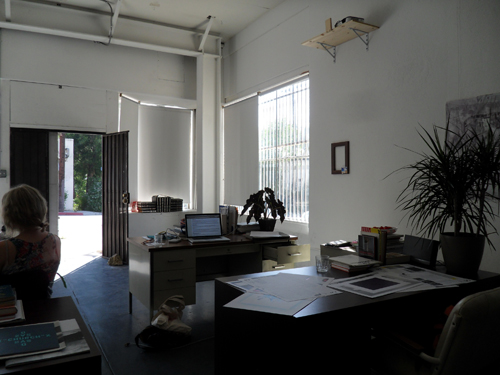
Public Fiction in Los Angeles, set up to look like a foreign correspondent’s office.
The vast majority of artist-run project spaces in Los Angeles tend to be casual and open-ended in nature, their raison d’être generally being to provide an alternative exhibition venue and gathering place for artists and their networks of friends. Standing out amongst this laid-back crowd is Public Fiction, a meticulously conceptualized venture launched in 2010 by curator and designer Lauren Mackler. Existing as both an exhibition/event space and a journal, Public Fiction energetically utilizes a variety of interrelated formats to explore themes and ideas that capture Mackler’s attention; over the last three years, these have included alternative spirituality, manifest destiny, and theatricality and sets, among others.
Rather than the typical setup of the journal acting as documentation or support for the live programming, Mackler has said that the programming initially existed in order to generate content for the journals, which are inspired by influential artists’ publications such as Wallace Berman’s Semina and Tom Marioni’s Vision. Both of those projects essentially collected original, not reproduced, artwork in print form; in the same way, Mackler, who designs the Public Fiction journals herself, attempts to translate live phenomena into print ephemera. The journals reference and collage events that have taken place in the physical space, but they also add other materials to make them into something new.
The first four issues of the Public Fiction journal. Courtesy Public Fiction.
Thematic explorations generally last about three months at Public Fiction, and as of this writing, it is in the midst of The Foreign Correspondent: Your Man in Los Angeles, a romantic exploration of international reporting both inspired and supported by the recent Ceci N’est Pas exchange initiative, which has brought many French artists to the city. The Public Fiction space has been outfitted with a grid of desks, evoking the newsrooms of yore, and it now functions as “an office, an exhibition, publication, performance, and residency.” In addition to producing a weekly dispatch edited by Mackler and Andrew Berardini, the “office” has hosted readings, screenings, a photography-themed exhibition, and a “secret restaurant” meal.
This may actually be the most personal of Mackler’s themes so far, as her own father was a foreign correspondent, a fact that played a huge role in her upbringing. Organizing the multitude of events and activities that comprise The Foreign Correspondent has perhaps enabled her to look back on elements of her past while engaging in the present; it may also highlight the degree to which Public Fiction constantly hearkens back to history, taking key moments and iconic gestures from the past and using them as springboards for experiments in the present.
Exterior of the Public Fiction space, while it was acting as the California Hotel.
I think back to the Gold Rush/Manifest Destiny series of late 2011—a meditation on the myths of California and westward expansion (no doubt influenced by Mackler’s own recent relocation from the East Coast) that played out in three phases. The first was La Californie, an exhibition co-curated by Mackler and Josh Peters of local artists, named after Picasso’s Mediterranean villa and emphasizing, among other qualities, bright colors and entrepreneurialism. The second was the transformation of Public Fiction into a fully functioning California Hotel, taking its cues and blessings from Al Ruppersberg’s 1971 Al’s Grand Hotel project, a classic example of cheeky California conceptualism. The hotel acted as a residency space for the Philadelphia–based collective Grizzly Grizzly and was also rented out to local artists. The final phase was a commissioned installation by David Hendren, who used frames, wires and paint to evoke the chaos and instability of earthquake territory.
David Hendren’s When…
The journal issue added more layers of investigation through selected images and commissioned texts, such as Lisa Anne Auerbach’s “Orgy Report” and Patrick Jackson’s discussion of Griffith Observatory as a stage set. Indeed, while the events that take place at Public Fiction provide constant stimuli within a lively interactive venue, the journals really are the gems of the project. To look through them is to experience a rich tumble of intellectual and historic inspiration, digested and burnished and re-fashioned. These works, informative and respectful of the past but with a strong appetite for fresh mixes, are not so much a distillation of occurrences as they are a new alchemical creation altogether.